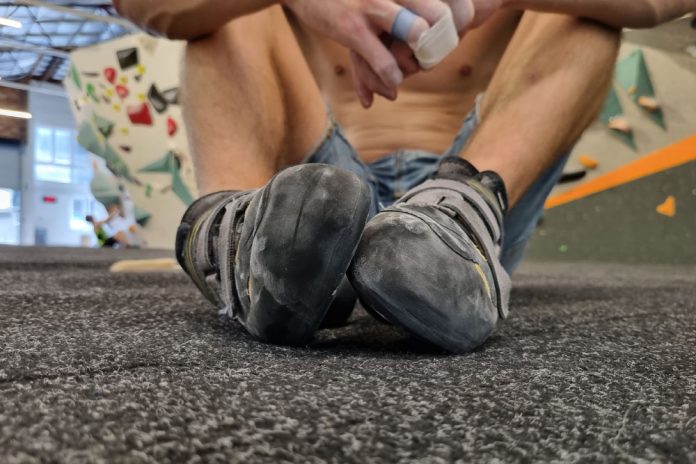Resole climbing shoes when the rubber sole becomes worn out or loses its grip, typically after several months or years of regular use. Climbing shoes need to be resoled when the rubber sole shows signs of wear and tear, such as a smooth or thin outer layer.
Resoling is also necessary if the sole starts to detach from the shoe or if the grip becomes less effective, compromising safety during climbs. The lifespan of climbing shoe soles depends on various factors including the frequency and intensity of use, the type of rock or surface climbed, and individual climbing style. Resoling climbing shoes can extend their lifespan and provide a cost-effective solution compared to purchasing new shoes.
When To Resole Climbing Shoes: Things to Check

Wear Patterns Check
When it is time to resole climbing shoes, there are several wear patterns to look for. One common sign is uneven tread wear, where certain parts of the sole are more worn out than others. This can indicate that the shoe is no longer providing proper traction and grip. Another sign is smoothed out edges on the sole, where the tread has become less defined and less effective. This can be particularly noticeable around the edges of the shoe. Additionally, visible damage to the sole, such as cuts or chunks missing, is a clear indication that resoling is necessary.
Performance Check Prior Climbing Shoe Repair
In repairing climbing shoes, there are notable changes in performance that climbers need to be aware of. One of the key changes is a decrease in friction and grip. As climbing shoes wear out, they may lose their ability to provide the same level of stickiness, making it harder to maintain a secure hold on small footholds. The decreased friction can also lead to a lack of sensitivity, making it more difficult to feel the rock and make precise movements. This can greatly impact a climber’s ability to tackle challenging routes and perform at their best.
Climbing Shoe’s Age And Usage Check
| Assessing the Shoe’s Age and Usage | |
| Determining the shoe’s mileage | Analyzing frequency of climbing |
| Check the sole for wear and tear, paying attention to areas that are often used, such as the toe and heel. If you notice significant reduction in grip or loss of tread pattern, it may be time to resole them. | Regular climbers may have to resole their shoes every six months or so, depending on the intensity and duration of climbs. If you only climb occasionally, your shoes may last longer before needing resoling. |
| Evaluating the shoe’s overall condition | |
| Look for any visible damage to the upper material, such as rips or tears, as these can affect the shoe’s performance and durability. If you notice any significant damage or deterioration, it may be time to consider resoling or replacing your shoes. | |
Resoling Climbing Shoe’s Cost-Benefit Analysis
Resoling can often be more cost-effective than purchasing a brand new pair, especially for high-quality climbing shoes. With the average resole cost ranging from $30 to $70, it is essential to assess the condition of the shoe and determine if it still offers good structural support and retains its original fit.
If the shoe is in good condition apart from the worn-out sole, resoling could be a viable option to extend its lifespan. However, if the shoe has significant damage or wear in other areas, it may be more beneficial to invest in a new pair. Additionally, the type and frequency of climbing activities should also be considered. Frequent climbers might find greater value in purchasing new shoes, while occasional climbers can benefit from resoling.
Availability Of Resoling Services
Look for local businesses or online services that specialize in climbing shoe resoling. Check customer reviews and ratings to ensure you choose a reliable and reputable service. Take into account the shipping costs and turnaround time when considering online resoling services. If you have local options available, it may be more convenient and cost-effective to choose a nearby service. By conducting thorough research and considering these factors, you can make an informed decision on when and where to resole your climbing shoes.
Resoling Impact On Climbing Shoe Fit And Performance
Resoling climbing shoes can have a significant impact on both the fit and performance of the shoes. As the soles wear down over time, the shape and structure of the shoe can change, affecting how it fits on the foot. This can lead to discomfort and decreased sensitivity when climbing. Additionally, the resoling process itself can cause changes to the shoe, depending on how it is done. It’s important to understand these potential changes and consider how they may affect your climbing performance.
Determining the effect on climbing performance is a crucial factor when deciding whether to repair your shoes. Consider if the shoes still provide enough grip and support for your climbing style and if any potential changes to the fit will impact your ability to climb comfortably. It’s also worth noting that resoling can extend the lifespan of your shoes, saving you money in the long run. Overall, understanding the potential changes to shoe shape and fit will help you make an informed decision on when to resole your climbing shoes.
Pros And Cons Of DIY Resoling
Resoling climbing shoes can be a cost-effective option that allows you to extend the life of your shoes. DIY resoling has both pros and cons to consider. One of the main advantages is the cost savings. By doing the resoling yourself, you can save money by not having to pay a professional to perform the task.
Another advantage is the skill and knowledge required. DIY resoling gives you the opportunity to learn more about the construction and maintenance of climbing shoes, which can be a valuable skill for climbers.
However, there are also some drawbacks to consider. The quality and durability of DIY resoling may not be on par with professional resoling. It requires practice and experience to ensure a proper and long-lasting resole.
Advantages Of Professional Resoling Services
When it comes to resoling climbing shoes, there are several advantages of opting for professional resoling services. These experts possess the expertise and specialized equipment required for the task, ensuring that the job is done accurately and efficiently. They have access to high-quality materials and adhesives, guaranteeing a durable and long-lasting resole.
Additionally, professional resoling services often offer guarantees and warranties, providing peace of mind to climbers. By taking advantage of these services, climbers can extend the lifespan of their shoes and maintain optimal performance on the rock.
User Experience: When It’S Time To Retire The Shoes
Over time, climbing shoe rubber will wear down, losing its grip and performance. When repeated resoling fails to restore the shoes’ original performance, it may be time to retire them. Look for signs such as excessive wear on the toe or heel, visible cracks or holes in the rubber, or a significant decrease in traction.
Ultimately, recognizing when it’s time to retire climbing shoes is a personal decision. It’s important to assess the level of wear and performance degradation, considering the purposes and risks associated with climbing. Regular shoe maintenance and inspection can help extend the lifespan of climbing shoes, but knowing when to replace climbing shoes and invest in a new pair is equally important for safety and performance.
When To Resole Climbing Shoes: User and Expert Analysis
When Should I Send My Climbing Shoes For Resole?
Send your climbing shoes for resole when the soles wear down, lose grip, or develop holes. Regularly inspect them for signs of damage or decreased performance. Expert resoling can extend the lifespan of your shoes, ensuring you climb with maximum comfort and safety.
Is It Worth To Resole Climbing Shoes?
Yes, it is worth resoling climbing shoes as it can extend their lifespan and save you money in the long run. By repairing the soles, you can maintain the fit, performance, and comfort of your shoes without needing to buy a new pair.
When Should I Get Resole?
Resole your shoes when you notice significant wear and tear on the soles. Pay attention to the level of traction, any holes, or unevenness. A professional assessment can help determine if your shoes are ready for resoling.
How Do You Know If Your Shoes Need Resoling?
To determine if your shoes need resoling, check for signs of excessive wear on the soles. Look for noticeable thinning or unevenness, loss of traction, or holes. Additionally, if you feel discomfort while walking or notice increased slipping, it may be time to resole your shoes.
Conclusion : When To Resole Climbing Shoes
When it’s time to resole your climbing shoes, a few signs can help you determine the right moment. Check for excessive wear and tear, loss of grip, and thinning of the rubber sole. Resoling can extend the life of your shoes, reduce costs, and maintain optimal performance on the rocks.
Keep an eye out for these indicators to ensure your climbing shoes stay in top condition for every adventure. Happy climbing!

